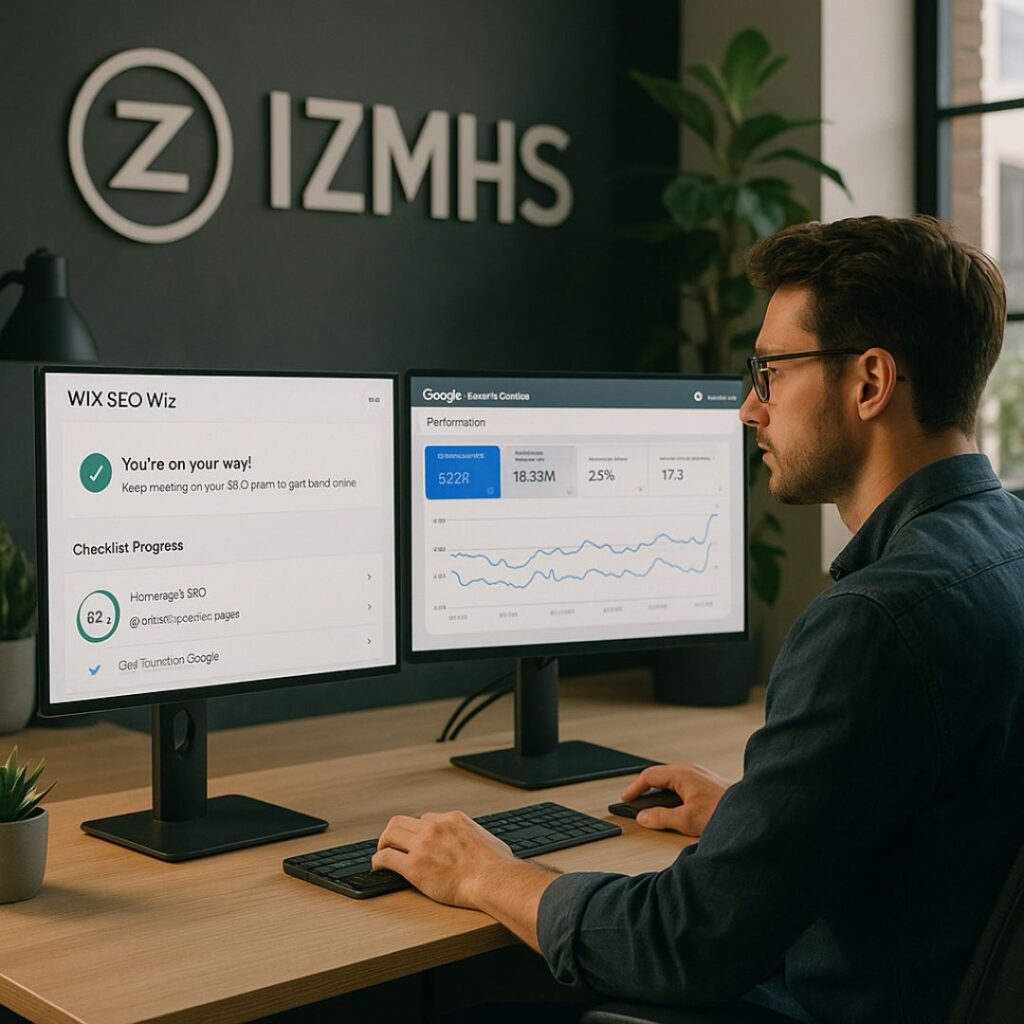Wix SEO Wiz for U.S Startups: SEO on a Budget from IZMHS
Introduction to SEO for Startups
If you’re a U.S.-based startup trying to gain visibility online, you’ve probably realized that SEO is both a blessing and a budget nightmare. But what if you could start ranking without hiring an expensive SEO agency?
Let’s talk about Wix SEO Wiz, your budget-friendly ally in the SEO world—especially when guided by experts at IZMHS.
Why SEO is Critical for U.S. Startups
Think of SEO like renting space on Google’s main street. If you’re not there, you’re invisible to your potential customers.
70% of users never scroll past the first page on Google.
Organic search drives over 53% of website traffic.
So, if your startup doesn’t show up—well, neither do your leads.

The Budget Barrier: Why Startups Avoid SEO
Here’s the truth: hiring an SEO agency in the U.S. costs anywhere from $1,000 to $5,000 per month.
Startups just can’t afford that in the early stage. That’s where Wix SEO Wiz becomes a game-changer.
What is Wix SEO Wiz?
A Built-in Tool for Entrepreneurs
Wix SEO Wiz is a free, AI-powered tool integrated into your Wix website. It helps you:
Set up SEO in minutes.
Create custom titles and descriptions.
Get step-by-step tasks to improve SEO performance.
How It Simplifies Technical SEO
You don’t need to know what a robots.txt file is. Or how to generate a sitemap. Wix does it for you:
Auto-generates and submits your sitemap to Google.
Updates canonical tags to avoid duplicate content.
Sets mobile-friendly meta tags out-of-the-box.
Why U.S. Startups Should Use Wix SEO Wiz
Cost-Efficiency vs Traditional SEO Agencies
Instead of spending thousands on external consultants, Wix SEO Wiz:
Gives you real, actionable SEO steps.
Is completely free for any Wix user.
Offers professional-level results, especially when combined with guidance from IZMHS.
User-Friendly Interface and Easy Setup
Anyone can use Wix SEO Wiz. It’s built for beginners:
No coding knowledge required.
Visual dashboards.
Clear SEO scoring system to track progress.
Step-by-Step Guide to Setting Up Wix SEO Wiz
Step 1: Accessing the SEO Wiz
Go to your Wix Dashboard → Marketing & SEO → Get Found on Google.
Step 2: Answering Business Questions
Wix asks for:
Your business name
Keywords you want to rank for
Your location (critical for U.S. startups!)
Step 3: Auto-Generating Your SEO Plan
Wix generates a custom SEO checklist tailored to your business and niche.
Step 4: Implementing the SEO Checklist
Tasks include:
Adding meta titles and descriptions
Connecting your domain
Submitting your site to Google Search Console
SEO Features in Wix That Startups Love
Custom Meta Tags & Descriptions
You can easily write SEO-optimized titles, URLs, and meta descriptions for every page.
Mobile Optimization Made Easy
Over 60% of traffic comes from mobile. Wix ensures every template is responsive.
Automatic Sitemap Submission
No need to deal with Google’s backend. Wix does it automatically.
Real Budget Benefits for U.S. Startups
Save on Costly SEO Consultants
Startups can DIY their SEO with the same impact—no monthly retainer needed.
Focus on DIY SEO with Confidence
With clear instructions and metrics, you’ll know what’s working and what’s not.
Time-Efficiency = Business Growth
Spend less time learning SEO and more time growing your business.
Local SEO and Wix for American Startups
Adding Business Info to Google My Business
Wix provides integration tips for GMB, helping you appear in local search results.
Boosting Local Visibility with Schema Markup
Structured data like business type, address, and opening hours can be added without coding.
Mistakes to Avoid When Using Wix SEO Wiz
❌ Ignoring Keyword Research
Don’t just guess your keywords—use tools like Ubersuggest or Google Keyword Planner.
❌ Not Updating SEO Settings Regularly
SEO isn’t one-and-done. Update your content and tags every 1–2 months.
LSI Keywords to Use with Wix SEO Wiz
| Primary Keyword | LSI Keywords |
|---|---|
| Wix SEO Wiz | SEO checklist, small business SEO, free SEO tools, DIY SEO guide |
| SEO for startups | budget SEO, startup digital marketing, Wix SEO tools, SEO without coding |
Long-Tail vs Short-Tail Keywords for Startups
Why Long-Tail Keywords Work Better for Startups
Less competition, more intent. Long-tail keywords like “how to use Wix SEO Wiz for free” bring targeted traffic.
Examples of Startup-Friendly Keywords
“Affordable SEO for startups”
“Wix SEO tips for small businesses”
“Wix SEO Wiz tutorial for beginners”
FAQ's
1. Is Wix SEO Wiz really free?
Yes! It’s built into every Wix website at no additional cost.
2. How long does it take to see SEO results with Wix SEO Wiz?
Typically 2–6 weeks, but many IZMHS clients see early movement within 10 days.
3. Can I use Wix SEO Wiz if I don’t know SEO?
Absolutely. It’s made for beginners with step-by-step guides.
4. Do I still need backlinks if I use Wix SEO Wiz?
Yes, backlinks help—but Wix SEO Wiz takes care of on-page SEO, which is step one.
5. Can I rank nationally with Wix SEO Wiz or only locally?
You can do both, but Wix is especially strong with local SEO optimizations.
Case Study: How IZMHS Helped a Startup Rank in 30 Days
Final Thoughts
A fashion ecommerce startup in NYC approached IZMHS. Using only Wix SEO Wiz, keyword strategy, and content tweaks, the startup:
Increased traffic by 65%
Appeared on page 1 for 4 keywords
Got indexed in Google within 48 hours
Final Thoughts from IZMHS
Wix SEO Wiz isn’t just a tool—it’s a startup’s secret weapon in the competitive online world.
At IZMHS, we’ve helped dozens of U.S. startups rank faster and grow smarter with zero extra SEO cost.
So, if you’re on Wix and want real results without the agency fees, the Wiz is your wizard 
For businesses seeking creative and technical excellence without the bloat of legacy systems, partnering with a Contra-vetted agency like IZMHS might just be the smartest move in 2025.








 Understanding Wix SEO Wiz
Understanding Wix SEO Wiz Why SEO Matters for U.S. Small Businesses
Why SEO Matters for U.S. Small Businesses Benefits of Using Wix SEO Wiz in 2025
Benefits of Using Wix SEO Wiz in 2025 2025 Updates to Wix SEO Wiz
2025 Updates to Wix SEO Wiz Real Success Stories
Real Success Stories How to Set Up Wix SEO Wiz
How to Set Up Wix SEO Wiz Wix SEO Wiz vs Other SEO Tools
Wix SEO Wiz vs Other SEO Tools Top SEO Tips for 2025 With Wix SEO Wiz
Top SEO Tips for 2025 With Wix SEO Wiz LSI Keywords & Their Role
LSI Keywords & Their Role Who Should Use Wix SEO Wiz?
Who Should Use Wix SEO Wiz? Pricing & Value
Pricing & Value
 What is Google Search Console?
What is Google Search Console? Why Combining Wix SEO Wiz and Google Search Console is Smart
Why Combining Wix SEO Wiz and Google Search Console is Smart Step-by-Step Guide to Connecting Wix SEO Wiz with Google Search Console
Step-by-Step Guide to Connecting Wix SEO Wiz with Google Search Console Features Breakdown: Wix SEO Wiz vs. Google Search Console
Features Breakdown: Wix SEO Wiz vs. Google Search Console Practical Tips for Small Businesses in the U.S.
Practical Tips for Small Businesses in the U.S. Wix SEO Wiz + GSC for E-Commerce Sites
Wix SEO Wiz + GSC for E-Commerce Sites Future-Proofing Your SEO Strategy
Future-Proofing Your SEO Strategy

